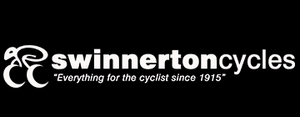Indoor Trainers 2: Tyre-Drive Turbo Trainers
Last time, we looked at Rollers – the original cycling indoor trainers. But what if you want to add some more resistance, simulating steep hills or intense sprints? Well, that’s where turbo trainers come in.
What's a Tyre-Drive Turbo Trainer?
Tyre-drive turbo trainers use a small A-frame to lift your rear wheel off the ground. The back of the frame has a small roller, attached to a resistance mechanism and flywheel. The tyre drives the roller, and away you go (except that you’re staying still). Most types of bike can be fitted to a tyre-drive trainer, although you may struggle to fit 29” wheels with tyres bigger than around 2” – check the specific model of trainer to see the maximum clearance.
On the more basic models, resistance is controlled via a handlebar remote. Fancier models will feature electronically controlled resistance, allowing the use of training software such as Zwift. The stiffness of the frame and clamp mechanism usually increases as you work your way up the price points - basic trainers tend to flex a lot, increasing slip between the roller and the tyre, limiting the amount of resistance you can apply. You’ll struggle to simulate more than around 6 or 7% gradients with a tyre-drive turbo trainer, no matter how high quality it is, before the tyres start to slip. For intense sprint or hill training, or e-sports racing, a direct drive smart trainer is the way to go.

Switching between different bikes is quite easy, compared to a Direct Drive Turbo Trainer. The trainer doesn’t interfere with the bike’s drivetrain, so you can easily swap between completely different bikes with completely different gears and wheel sizes. However, tyre-drive trainers are predominantly designed around bikes with quick-release wheels, and smaller tyres. You can purchase adaptors for most thru axle bikes, but this adds expense, particularly if you have several different bikes which use different thru axles. If you have a bike with particularly large tyres and a wide or off-set rear end, you might not be able to get the tyre to line up with the roller properly.

Speaking of tyres, you’ll probably want to use a dedicated trainer tyre if you plan on using your trainer regularly. Tyre-drive trainers rely on friction between the tyre and the roller. This causes a lot of heat and noise, and leads to quite considerably accelerated wear on the tyre. Knobbly tyres are almost impossible to use for any kind of serious workout. Turbo tyres are made of a very hard rubber compound which is much more wear resistant, and doesn’t make as much noise. However these are not safe to ride outside. If you plan to switch between indoor and outdoor training sessions, it may be best to invest in an additional wheel, tyre and cassette to switch in and out. If you have multiple bikes which all require trainer tyres, spare wheels and axle adaptors, the initial low price of the trainer may be a bit of a false economy compared with a direct drive trainer. If you will be riding upstairs, or in a flat, put your trainer on a thick carpet or yoga mat to reduce noise.
Pros:
Relatively inexpensive
Compact
It's easy to swap between lots of different bikes (with quick release wheels)
Cons:
Primarily suited to older bikes with smaller tyres and quick-release wheels
Turbo tyres can be very difficult to fit
Very noisy
Limited resistance
Ready to turbocharge your training?
Our Recommendations:

Entry Level: Elite Novo Force
If you want to take your first steps into indoor training, the Elite Novo Force trainer is a good option. It has a sturdy, stiff construction which will withstand some serious efforts, though it lacks the smart features of more expensive models. Make sure you factor a turbo tyre and any necessary axle adaptors into your budget. This trainer is also great for race day warm-ups in the car park - no electronics required.

Best Basic Trainer for Regular Use: Tacx Boost
If you’re planning to use your trainer regularly, and just want a simple, reliable unit with no built-in electronics to go wrong, the Tacx Boost trainer is great. You can also buy it as a bundle with Garmin speed and cadence sensors, allowing you to record your workouts and upload them to platforms such as Garmin Connect or Strava through a compatible head unit.
Best Smart Turbo: Tacx Flow Smart Interactive Trainer
Unlike the other tyre-drive trainers listed above, the Tacx Flow requires a power supply to work. However, in return, you’ll be able to use online training platforms like Zwift. Any trainer will allow you to send data to these platforms if you have the appropriate sensors, but only an interactive trainer will be able to receive instructions from them, allowing you to ride simulated courses or follow structured training plans, without having to adjust the resistance yourself from the handlebars. However, as this trainer only simulates up to 7% gradient, you’ll find you’re at a disadvantage when riding with other people. It can only handle a maximum of 800 Watts, so not much use for sprint training, unless you’re a particularly small, lightweight rider. Again, in this case it’s much better to look at Direct Drive Smart Trainers.


